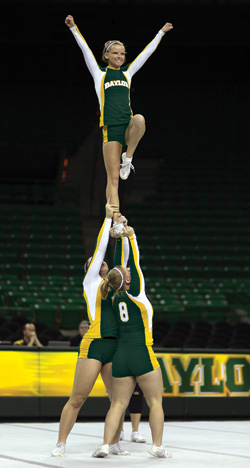5 Things You Should Know About Competitive Cheer
5 things you should know about Competitive Cheer
Last fall, competitive cheer began as Baylor's 19th varsity sport. But it's not only new at Baylor -- it's a brand new sport, period, and it's probably not quite what you picture. That's why we've put together 5 things you should know about Competitive Cheer.
- This is something entirely new. Picture a combination of a spirit squad, gymnastics, and the cheerleading competitions ESPN airs from time to time, and you'll be on the right track. It was originated at the University of Maryland in 2003, and Baylor is currently one of six schools that belong to the National Collegiate Acrobatics and Tumbling Association (BU, Maryland, Azusa Pacific, Fairmont State, Oregon and Quinnipiac).
- Though new, the sport is rapidly growing. Eighteen months ago, competitive cheer was barely on anyone's map. The sport now has six universities competing with expectations of reaching 10 (enough for NCAA Emerging Sport status) by next fall and perhaps as many as 16-20 schools by fall 2012. The sport's name could change -- the "acrobatics and tumbling" moniker in the national association's title might be a better description -- but by any name, the sport is expected to expand quickly.
- Here's how a meet works. Between two and four teams (each featuring 25-30 participants) compete in a meet that lasts about two hours. Each meet is made up of six events: compulsories (a test of several standard skills), stunting (a preset routine of gymnastics-style activities), pyramid formation, basket toss, tumbling (individual and synchronized) and the team routine (a two-minute-30-second, choreographed group performance). Judges evaluate each event, and the team with the highest score at the end of the meet is the winner. Meets are held December to March, with the NCATA championships in April.
- These are scholarship student-athletes, just like any other varsity sport. Being Baylor's first year, the all-female roster currently includes 27 women; over time, that will grow to about 40. Like baseball, softball and many other sports, competitive cheer is an "equivalency sport," meaning head coach Karry Forsythe has 12 scholarships to divide among her entire roster. Positions on the team include "bases" (the girls on the sides of the stunt), "back spots" (who keep the girls on top from falling forward or backward) and "fliers" (the fearless ones who, well, go flying).
- Baylor is in a good place to become a powerhouse in the sport. As one of the six founding members of NCATA, Baylor has a seat at the table as the sport really becomes grounded; in fact, Forsythe is in charge of rules, procedures and policies for the national association. Forsythe and the Bears also have a built-in recruiting edge as the only participating university in Texas -- a hotbed for cheerleading competitions at the club and high school level. Baylor's first two home meets averaged almost 700 fans each at the Ferrell Center.
For more information, visit thencata.org or the competitive cheer page at BaylorBears.com.
